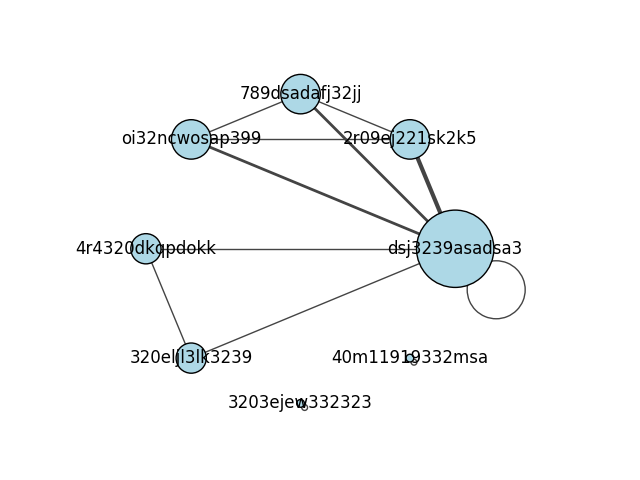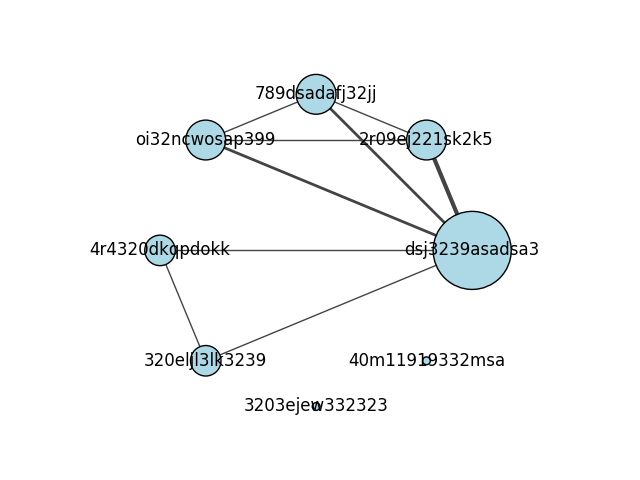Note
Click here to download the full example code
Online user actions
This example reproduces a typical data science situation in an internet company. We start from a pandas DataFrame with online user actions, for instance for an online text editor: the user can create a page, edit it, or delete it. We want to construct and visualize a graph of the users highlighting collaborations on the same page/project.
import igraph as ig
import numpy as np
import pandas as pd
import matplotlib.pyplot as plt
Let’s start by preparing some toy data representing online users. Each row indicates a certain action taken by a user (e.g. click on a button within a website). Actual user data usually come with time stamp, but that’s not essential for this example.
action_dataframe = pd.DataFrame([
['dsj3239asadsa3', 'createPage', 'greatProject'],
['2r09ej221sk2k5', 'editPage', 'greatProject'],
['dsj3239asadsa3', 'editPage', 'greatProject'],
['789dsadafj32jj', 'editPage', 'greatProject'],
['oi32ncwosap399', 'editPage', 'greatProject'],
['4r4320dkqpdokk', 'createPage', 'miniProject'],
['320eljl3lk3239', 'editPage', 'miniProject'],
['dsj3239asadsa3', 'editPage', 'miniProject'],
['3203ejew332323', 'createPage', 'private'],
['3203ejew332323', 'editPage', 'private'],
['40m11919332msa', 'createPage', 'private2'],
['40m11919332msa', 'editPage', 'private2'],
['dsj3239asadsa3', 'createPage', 'anotherGreatProject'],
['2r09ej221sk2k5', 'editPage', 'anotherGreatProject'],
],
columns=['userid', 'action', 'project'],
)
The goal of this example is to check when two users worked on the same page. We choose to use a weighted adjacency matrix for this, i.e. a table with rows and columns indexes by the users that has nonzero entries whenever folks collaborate. First, let’s get the users and prepare an empty matrix:
users = action_dataframe['userid'].unique()
adjacency_matrix = pd.DataFrame(
np.zeros((len(users), len(users)), np.int32),
index=users,
columns=users,
)
Then, let’s iterate over all projects one by one, and add all collaborations:
for project, project_data in action_dataframe.groupby('project'):
project_users = project_data['userid'].values
for i1, user1 in enumerate(project_users):
for user2 in project_users[:i1]:
adjacency_matrix.at[user1, user2] += 1
There are many ways to achieve the above matrix, so don’t be surprised if you came up with another algorithm ;-) Now it’s time to make the graph:
g = ig.Graph.Weighted_Adjacency(adjacency_matrix, mode='plus')
We can take a look at the graph via plotting functions. We can first make a layout:
layout = g.layout('circle')
Then we can prepare vertex sizes based on their closeness to other vertices
vertex_size = g.closeness()
vertex_size = [0.5 * v**2 if not np.isnan(v) else 0.05 for v in vertex_size]
Finally, we can plot the graph:
fig, ax = plt.subplots()
ig.plot(
g,
target=ax,
layout=layout,
vertex_label=g.vs['name'],
vertex_color="lightblue",
vertex_size=vertex_size,
edge_width=g.es["weight"],
)
plt.show()

Loops indicate “self-collaborations”, which are not very meaningful. To filter out loops without losing the edge weights, we can use:
g = g.simplify(combine_edges='first')
fig, ax = plt.subplots()
ig.plot(
g,
target=ax,
layout=layout,
vertex_label=g.vs['name'],
vertex_color="lightblue",
vertex_size=vertex_size,
edge_width=g.es["weight"],
)
plt.show()

Total running time of the script: ( 0 minutes 0.372 seconds)